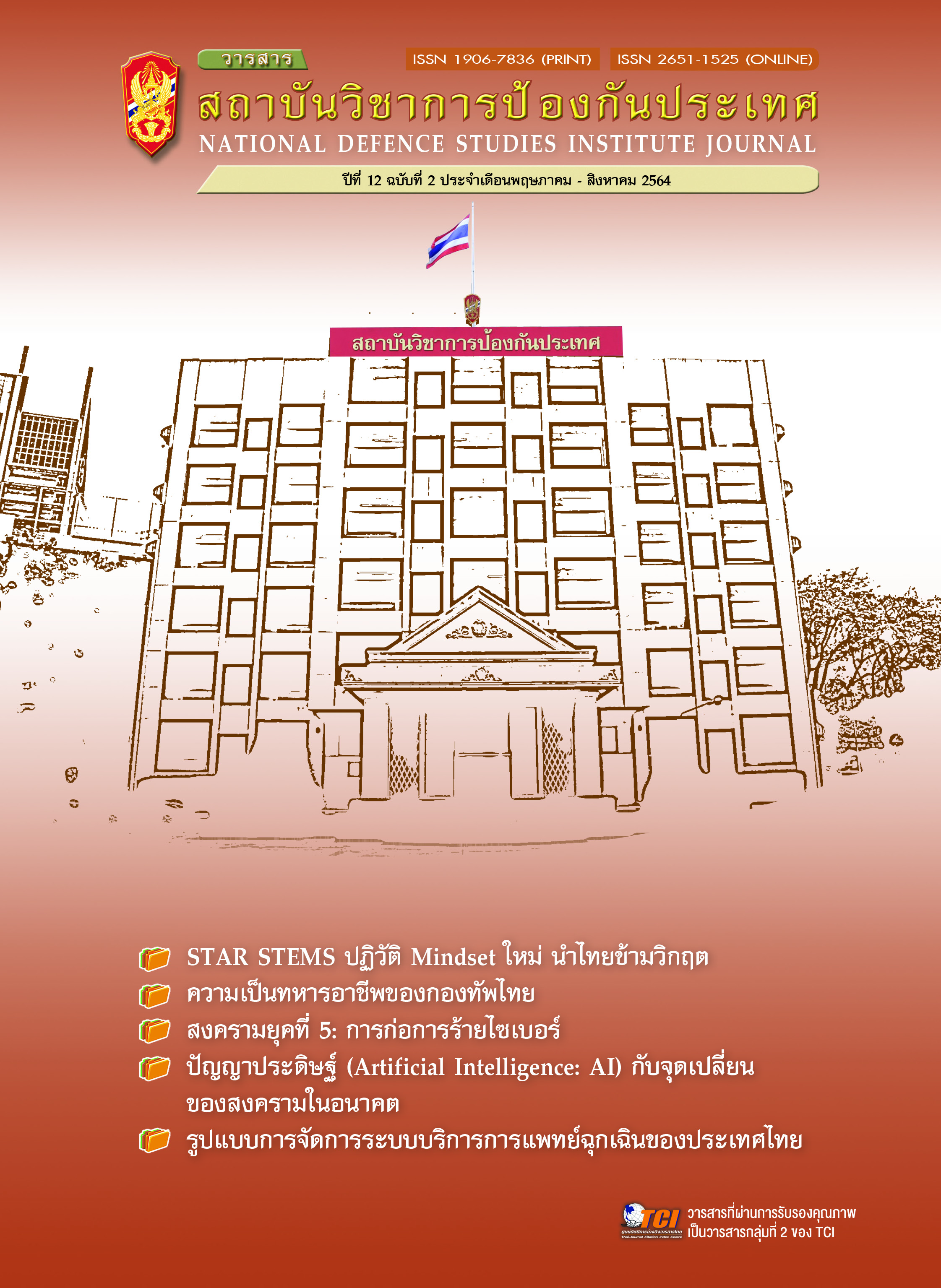Thailand Emergency Medical Services System Management Model
Main Article Content
Abstract
The study of “Thailand Emergency Medical Services System Management Model” has objectives 1) to study the current condition of Thailand Emergency Medical Services (EMS) system, 2) to study the feasibility of Thailand EMS system management model, and 3) to study the feasibility and appropriateness in terms of the law and morality of the Thailand EMS system management model. The research is qualitative research using the methods of documentary study and in-depth interviews with 20 key informants who have been selected from experts, executives, practitioners, and emergency medical stakeholders in public and private sectors. The research tools used are semi-structured interviews. The data is analyzed by typological analysis and comparative analysis. The analysis result is used to determine a proposal for the Thailand EMS system management model by 7’S Framework of McKinsey.
The results are as follows:
- 1. Thailand EMS system management model should have a combination of the Franco- German (FG) model, Anglo-American (AA) model, and Fire based design model. The combination should be chosen from the feasibility model which is appropriate in the context of the region. There is a specific Emergency Medicine Act B.E 2551 and the establishment of the National Institute of Emergency Medicine (NIEM) which determine the directions, policies, and structures of EMS development in accordance with the intent of the law. Local government organizations are encouraged to participate in emergency medical operations and provide a free service through the 1669 hotline to serve emergency patients with standardized access within 8 minutes,the emergency medical fund to support the costs of emergency medical operations. However, there is still a lack of supportive actions from the federal funding to provide vehicles for local emergency medical operations. The NIEM is responsible for providing an emergency operating system, including the management and development of communication and information technology systems for the benefit of emergency medical operations as well as establish standards and criteria for out-of-hospital emergency care from the acknowledgment of emergency cases until the delivery of the emergency patients to the hospital. 2. The proposal for Thailand EMS system management model is found to be possible and suitable in terms of law and morality in various aspects. 1) Strategy: They should adopt the concept called “triangle to move the mountain” for analyzing the situation from external to internal areas and the stakeholders, search gaps (gap analysis) to define the vision and mission in line with the direction of national reform policy and plan for the national strategy; and set a strategic map in short, medium, long terms with the ultimate goals to reduce the mortality and disability rates from emergency cases. 2) Structure: In the future, EMS should be a unified system which is based on the same service platform, adjust the role of NIEM as a policy equipment, determine the regulation and EMS board (KorPorChor) at the regional level whose missions are to drive, govern and direct EMS as the local management, change EMS from hospital-based to community based and integration with volunteer based as citizen-centric. The creation of a specific model is suitable for the area. There should be three levels of structural relationship: central government body, regional government body, and local government body. 3) System: The design of an EMS system management model should be an independent system as well as a unified system on the same platform with the regulatory mechanism of financial regulation, especially the local EMS board and define a free EMS payment model by the central government in conjunction with the local government as the purchaser. The public and private sectors should join the providing of EMS service as fee-for-service fee and allow the people to co-pay in case of the special service. Moreover, they also have to focus on the development of EMS standards and quality. 4) Style: They should focus on EMS development and the regional medical direction. 5) Staff: They should focus on the development of high-level operators who develop a community-based model with appropriate career paths and compensation. 6) Skill: Operators must have competency and creativity. 7) Shared Value: The excellent organizations should have shared values in three areas, namely 1) continuity of quality development, 2) 3P safety concern, and 3) ethics and code of conduct.
Article Details

This work is licensed under a Creative Commons Attribution-NonCommercial-NoDerivatives 4.0 International License.
The articles, images, tables, graphs, written content, and opinions published in this journal are solely those of the authors and do not necessarily reflect the views or positions of the National Defence Studies Institute or its academic affiliates.
References
กระทรวงสาธารณสุข กองยุทธศาสตร์และแผนงาน. (2561) สถิติสาธารณสุข พ.ศ.2561.
กัญญา วังศรี. (2556). การบริการการแพทย์ฉุกเฉินในประเทศไทย. ศรีนครินทร์เวชสาร, 28(4), 69-73.
จารุวรรณ ธาดาเดช, สิริมา มงคลสัมฤทธิ์, และไพบูลย์ สุริยะวงศ์ไพศาล. (2557). วิวัฒนาการระบบบริการการแพทย์ฉุกเฉินในประเทศไทย: การทบทวนวรรณกรรมอย่างเป็นระบบ.
“พระราชบัญญัติการแพทย์ฉุกเฉิน พ.ศ.2551” (2551, 6 มีนาคม). ราชกิจจานุเบกษา. เล่ม 125 ตอนที่ 44 ก. หน้า 1-17
มหาวิทยาลัยหอการค้าไทย. (2561). โครงการสำรวจการรับรู้และความพึงพอใจของผู้ใช้บริการต่อระบบบริการการแพทย์ฉุกเฉินแห่งชาติ. จาก https://www2.niems.go.th/th/View/ContentDetails.aspx?CateId=113&ContentId=25620522040544596&Page=0
วาโร เพ็งสวัสดิ์. (2553). การวิจัยพัฒนารูปแบบ. วารสารมหาวิทยาลัยราชภัฏสกลนคร, 2(4), 1-15
สถาบันการแพทย์ฉุกเฉินแห่งชาติ. (2561). แผนหลักการแพทย์ฉุกเฉินแห่งชาติ ฉบับที่่ 3.1 พ.ศ.2562-2564 (ปรับปรุงจากแผนหลักการแพทย์ฉุกเฉินแห่งชาติ ฉบับที่่ 3 พ.ศ.2560-2564). นนทบุรี: สถาบันการแพทย์ฉุกเฉินแห่งชาติ.
สุพรรณี ไชยอัมพร. (2552). การวิจัยเชิงคุณภาพเพื่อการพัฒนา: แนวความคิด วิธีการและการประยุกต์ใช้. กรุงเทพฯ:แผนกการพิมพ์ วิทยาลัยเทคนิคมีนบุรี.
สำนักงานวิจัยเพื่อการพัฒนาหลักประกันสุขภาพไทย และเครือสถาบันวิจัยระบบสาธารณสุข. (2556). รายงานการ ทบทวนการพัฒนาระบบบริการการแพทย์ฉุกเฉินต่างประเทศ ภายใต้โครงการ “การทบทวนประสบการณ์ต่างประเทศ ในการพัฒนาระบบบริการการแพทย์ฉุกเฉิน. นนทบุรี: สถาบันการแพทย์ฉุกเฉินแห่งชาติ.
สำนักนโยบายและแผนการขนส่งและจราจร. (2562) รายงานการวิเคราะห์สถานการณ์อุบัติเหตุทางถนนของกระทรวงคมนาคม พ.ศ.2561.


